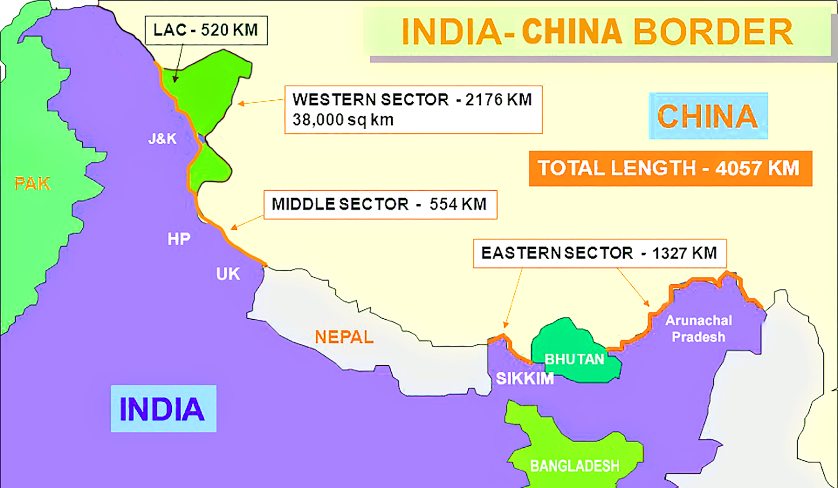China Objects Indo-US Military Drill Near LAC
For Prelims: India - China Relations, India-China Border Agreements, LAC, LoC, Yudh Abhyas.
For Mains: Issues related to India - China relations and the way forward.
Why in News?
Recently, China opposed the war games between India and the US near the disputed Sino-India border, saying it’s an interference in the bilateral boundary issue.
- While the drill is yet to be officially confirmed, it is anticipated that the two countries will participate in the 18th edition of the “Yudh Abhyas” at Auli in Uttarakhand in October 2022, some 100km from the Line of Actual Control (LAC).
Why Does China Oppose the Military Drill near LAC?
- China says both countries have agreed that no military drill will be held near the LAC, the de facto border between the two countries.
- China cited two agreements signed by India and China in 1993 and 1996, saying the exercise violates both.
- 1993 Agreement on the Maintenance of Peace and Tranquillity along the Line of Actual Control in the India-China Border Areas.
- 1996 Agreement on Confidence-Building Measures in the Military Field Along the Line of Actual Control in the India-China Border Areas.
- A key element of both the 1993 and 1996 agreements is that the two sides would keep their forces in the areas along the LAC to a minimum level. However, the agreements do not define what comprises the minimum level.
- The 1993 and 1996 agreements also mandate that pending a final solution to the boundary question, the two sides shall strictly respect the LAC.
- Use of firearms on the LAC is strictly regulated as per the agreements of 1993, 1996 and 2005.
What is Yudh Abhyas?
- It is the largest running joint military training and defence cooperation endeavor between India and the US.
- The exercise was started in 2004 under the US Army Pacific Partnership Program. The exercise is hosted alternately between both countries.
- The exercise aims at enhancing understanding, cooperation and interoperability between two Armies.
- This will help them in undertaking joint operations at battalion level in mountainous terrain with cold climatic conditions under the ambit of the United Nations.
What is the Point of Contention between two countries?
- The major disagreements are in the western sector.
- After the 1962 War, the Chinese claimed they had withdrawn to 20 km behind the LAC in November 1959.
- In the eastern sector the border coincides in the main with the so-called McMahon Line, and in the western and middle sectors it coincides in the main with the traditional customary line which has consistently been pointed out by China.
- During the Doklam crisis in 2017, China urged India to abide by the “1959 LAC”.
- India rejected the concept of LAC in both 1959 and 1962.
- India’s objection was that the Chinese line “was a disconnected series of points on a map that could be joined up in many ways, the line should omit gains from aggression in 1962 and therefore should be based on the actual position on September 8, 1962 before the Chinese attack, and the vagueness of the Chinese definition left it open for China to continue its creeping attempt to change facts on the ground by military force.
What are the Recent Issues and Developments between India and China?
- Issues:
- May 2020: Chinese and Indian forces clashed at Nathu La, Sikkim (India).
- June 2020: Indian and Chinese armies were engaged in the standoff in Pangong Tso, Galwan Valley, Demchok and Daulat Beg Oldie in eastern Ladakh.
- June 2020: India banned 59 apps originating from China.
- November 2020: India blocked 43 new mobile apps, mostly Chinese.
- The ban has been enforced under Section 69A of the Information Technology Act, 2000.
- Developments:
- February 2021: India and China decided to finally reach an agreement on disengagement at Pangong Lake.
- September 2022: Recently, Indian and Chinese armies have begun to disengage from Patrolling Point-15 in the Gogra-Hot Springs area of Eastern Ladakh, marking a step forward to end the standoff ongoing since May 2020.
What is the Line of Actual Control?
- The LAC is the demarcation that separates Indian-controlled territory from Chinese-controlled territory.
- India considers the LAC to be 3,488 km long, while the Chinese consider it to be only around 2,000 km.
- It is divided into three sectors,
- The eastern sector which spans Arunachal Pradesh and Sikkim.
- The middle sector in Uttarakhand and Himachal Pradesh
- The western sector in Ladakh.
How is the LAC different from the Line of Control with Pakistan?
- The LoC emerged from the 1948 ceasefire line negotiated by the UN after the Kashmir War.
- It was designated as the LoC in 1972, following the Shimla Agreement between the two countries.
- It is delineated on a map signed by Director General of Military Operations (DGMOs) of both armies and has the international sanctity of a legal agreement.
- The LAC, in contrast, is only a concept – it is not agreed upon by the two countries, neither delineated on a map or demarcated on the ground.
Way Forward
- As two big emerging economies, China and India need to pursue development alongside each other, move forward in partnership instead of hindrance, and work together for shared progress rather than erecting walls against each other.
- India and China also need to advance the boundary talks to build up mutual trust and realize peace and tranquility in the border areas.
UPSC Civil Services Examination Previous Year Question (PYQ)
Q. “China is using its economic relations and positive trade surplus as tools to develop potential military power status in Asia”. In the light of this statement, discuss its impact on India as her neighbour. (2017)
